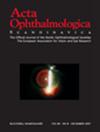New insights on the genetic basis underlying hereditary high myopia in a cohort of more than 100 spanish families
Abstract
Aims/Purpose: This study focuses on the identification of new mutations and novel genes associated with hereditary high myopia, in order to determine the most prevalent variants in the Spanish population and to stablish the clinical characterization through the study of genotype-phenotype correlations.
Methods: 119 Spanish families (390 patients) were recruited. DNA samples from 347 patients were analysed by Whole Exome Sequencing. In silico analyses were carried out prioritising a custom-designed panel of 549 genes related to myopia. Clinical ophthalmological assessments were performed to all the study subjects.
Results: Genetic analysis was performed in 102 families affected by high myopia. In more than 20% of them, a clear genetic cause was identified in genes already involved with high myopia. Additionally, potentially pathogenic variants in the myopia-related genes were identified in about 25% of the cases, and in 15% of the families, we identified likely pathogenic variants in candidate genes that have not yet been directly associated to myopia. These evidence lead us to estimate the genetic diagnosis in approximately 50% of the families. High myopia genes found can be classified into 4 groups according to their function: extracellular matrix, retina expression, SMAD family and others. Differences in clinical characterization between groups were observed.
Conclusions: We were able to point out a possible genetic cause in about 50% of the families. Furthermore, we target new genes that could be involved in the molecular basis of hereditary high myopia, expanding the knowledge of this condition. High pathological myopia can be correlated to the gene function.
References: High myopia occurs when the spherical refractive error exceeds -6.00 diopters or the axial length of the eye is greater than 26 mm. Genetic factors play a crucial role in its development, since it has an estimated heritability in more than 70% of cases, according to the literature.

 求助内容:
求助内容: 应助结果提醒方式:
应助结果提醒方式:


